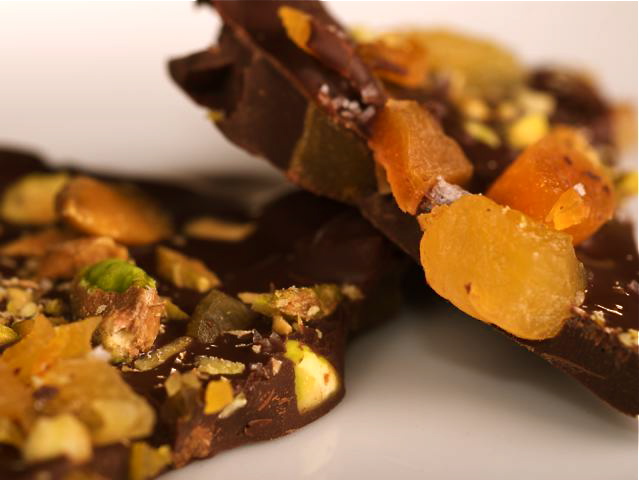
reference-image, l
(article, Deborah Madison)
[%pageBreakSettings nobreak=true] I just went to the first holiday party of the year, and when all the sweets came out, I thought, “Uh-oh, here come the pounds. I need to spend more time chopping wood.” [[block(sidebar). h1.Featured recipes]] But my husband and I had already cut and stacked all the old logs and tree branches we had, so I knew there had to be some other strategy for the season of friends, shared meals, and of course, desserts. Preferably, desserts that don’t take a lot of your precious time or fill you up with unwanted substances. I love winter desserts. After running to keep up with summer's perishable stone fruits, I appreciate the inertness of dried fruits, nuts, and chocolate, along with the season’s first citrus, which I think of as slow fruits in that you don’t have to keep your eye on them the way you have to watch a peach. Winter foods are something of a relief to deal with, which is a good thing, because there’s a lot of other activity commanding our attention. So here are a few desserts with the inherent advantages of being uncomplicated, versatile, festive, and not too damaging to one’s figure or health. Of course, they’re good to eat, too. [%image reference-image float=right width=400 caption="Homemade chocolate bark with nuts and dried fruit."] Fresh fruit. Satsuma tangerines begin in November and are especially good around Christmas. Oranges are coming in. There are handsome Comice pears that you buy firm and allow to ripen over a few days before putting out with the season’s new crop of walnuts and almonds. If you’re a fan of cheese, have a plate of two or three cheeses with your pears — blues, goats, goat blues, hard cheeses like Vella’s two-year-old Dry Jack, or a soft Latour. A small glass of dessert wine would be festive as well. Dried fruit. Moist dried figs closed around a toasted almond or walnut are very nice with a glass of anise liqueur and a simple nut cookie. But dates have just been picked by Christmas, and I like to stuff these as well. Buy some almond paste, mix it with a drop of pink or orange food coloring, and flavor it with rose or orange-flower water. Then roll the paste into little ovals and replace the date’s seeds with it. Put the stuffed dates in paper cases, and you have dessert. Dried-fruit compote looks gorgeous, keeps well, and is cool, delicious, and versatile. Does dried fruit simmered in water with honey and a vanilla bean sound dull? Trust me, it’s not, especially if you’ve looked in your farmers' market for some interesting dried fruits, such as red plums (not prunes), nectarines, different kinds of dried cherries, peaches, and pluots. (You can also get dried peaches and a variety of cherries at Trader Joe’s, or beautiful little pale green raisins and organic prunes at a co-op grocery store.) Once you’ve made your compote (a matter of 20 minutes or so), you can keep it in the refrigerator for weeks to serve on a plate topped with heavy cream, yogurt, or crème fraîche. Add a few cookies on the side, too. Go beyond the basic dried-fruit compote recipe by poaching the fruit in equal parts water and wine, such as a Riesling. (Red wines are good too, but they obscure the colors of the fruit.) If you go for barks and berries, add a cinnamon stick, 2 cloves, cardamom seeds, toasted peppercorns, and the like to the water or wine as the fruit is poaching. I don’t strain them out, because I like the way they look, plus it’s pleasantly startling to bite down on a bit of spice. It wakes you right up! Slice some fresh fruit and include it in the compote. Like what? A peeled Fuyu persimmon, poached quince, poached pears, a sectioned orange, or pomegranate seeds. The fresh fruit provides a nice contrast to the dried fruit. When you’ve started to run out of compote, dice the fruit into smaller pieces and serve them, with their syrup, over ice cream, alongside a cake, or as a garnish to ricotta cheese or a cheesecake. Chocolate bark. This is a winter dessert that’s both festive and practical. Chocolate barks are insanely easy to make and terrific to have on hand for winter entertaining. You can make them with dark chocolate or white, and you can make them interesting and beautiful in so many ways. Covered and refrigerated, chocolate bark keeps well — theoretically, anyway, although it probably won't sit around long enough for you to find out. For a dessert platter featuring chocolate bark, get out a tray and a selection of pretty dishes. Break the chocolate bark into jagged pieces and put them in a dish. Fill a small bowl with some tangerines. You might have some chunks of pomegranates on another dish. Definitely include a pile of luscious Medjool dates, a bowl of walnuts and a nutcracker, or perhaps dried figs stuffed with roasted almonds and anise seeds. You might also include a small cheese. Add anything else you like to nibble on, and bring it all to the table. Pour a dessert wine and take a seat. You’ll find that people can pick endlessly at all these bites, putting them together this way and that. The conversation continues, and no one leaves feeling stuffed — just beautifully fed. p(bio). Deborah Madison is the author of numerous award-winning cookbooks, including Local Flavors. She lives in New Mexico.

reference-image, l